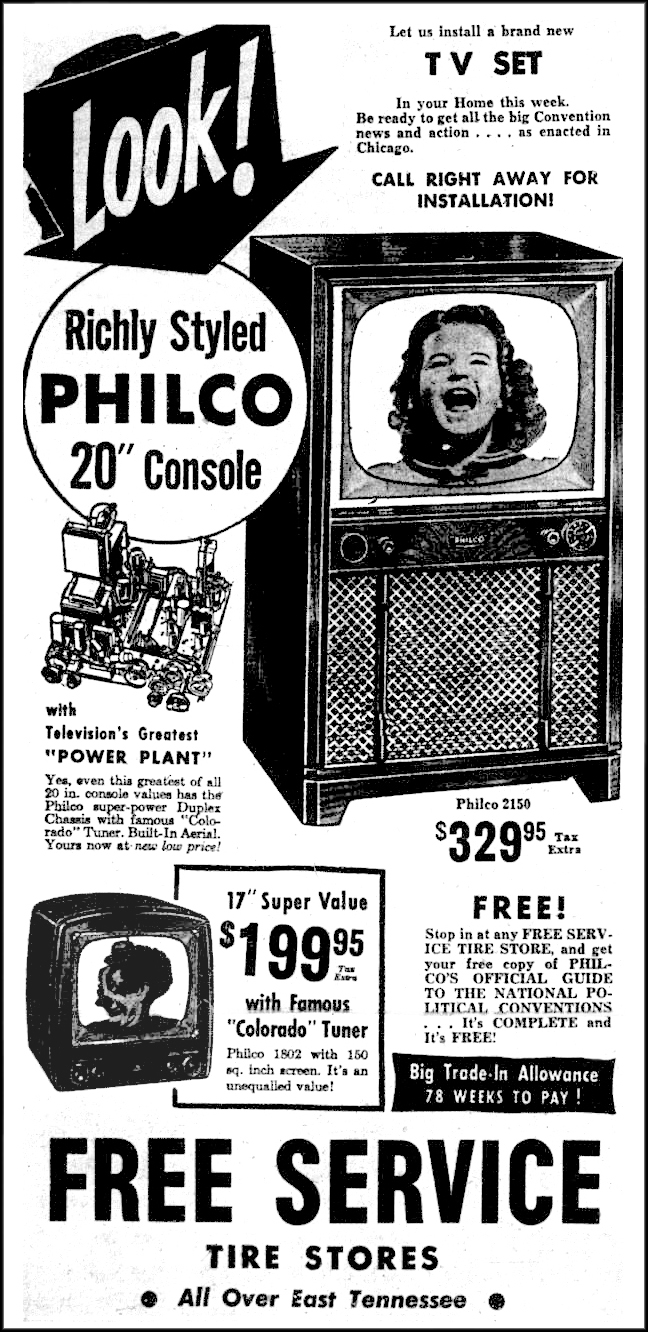The recent passing of W. Hanes Lancaster, Jr. evoked my recollections and fondness of early television comedians whom I eagerly looked forward to watching every week. The following is an brief exercise to see how many of the funnymen listed below you can match with their corresponding descriptors. If you do well on it, you are likely on Social Security.

Free Service Tire Stores Philco TV Advertisement, 1954
Here are the names: 1. Milton Berle, 2. Jackie Gleason, 3. Sid Caesar, 4. Red Skelton, 5. Bob Hope, 6. Jack Benny, 7. Jimmy Durante, 8. Ed Wynn, 9. Eddie Cantor and 10 Ernie Kovacs.
Here is the information about each one. The answers are revealed at the end.
A: Known as “Mr. Television.” Credited with boosting television sales with his brash and raucous comedy and zany guests. Hosted “The Texaco Star” program that was broadcast every Tuesday night from 1948 until 1956.
B: Hit the big screen in 1952. Favorite expression when he became exasperated, was “Well!” Owned a Maxwell automobile. Kept his money in a heavily guarded and fortified underground vault in his basement. Good violinist but purposely played his violin poorly to incite laughs. Reportedly made provisions to sent his wife a single red rose long after his passing.
C: Evolved from the stages of vaudeville. Appeared on 1950s television on such shows as “The Colgate Comedy Hour,” “All Star Revue” and “Four Star Revue.” Acquired the nickname, “The Schnoz” because of his particularly large snout. Played piano and sang. Theme song: “Inka Dinka Doo.” Concluded each show with the expression, “Good night, Mrs. Calabash, wherever you are.”
D: Had a long and illustrious career in all aspects of show business. First became known to television audiences in 1950 on “The Colgate Comedy Hour.” Trademarks were his banjo eyes and outstretched hands. Served as host of a TV syndicated comedy theatre that bore his name.
E: Signed on to television in 1951. Performing in several series that originated in Philadelphia. Usually seen holding a cigar. Acquired his own series in 1955. Became especially creative using cameras and other technical equipment to produce visual deception. Portrayed an exaggerated character, the lisping, half-soused poet, Percy Dovetonsils.
F: Made folks laugh with his distinctive facial expressions. Journey to stardom included a 90-minute program titled “Your Show of Shows.” An accomplished saxophonist. He and co-star, Imogene Coca acted out skits with realism. Talented at performing on a bare stage without elaborate props or embellished costumes.
G: Successfully transferred from radio to television. Became an American institution. After starring in several shows, began offering monthly specials. Brought much attention each year by taking his Christmas program overseas to cheer lonesome servicemen. Became a pro at generating laughter with barbed comments on social and political issues. Died soon after reaching the age of 100.
H: Heavyweight who once fractured his leg during a show skit that allowed him to convert reality into comedy. Was chosen to be the first season's Chester A. Riley in the hit TV show, “The Life of Riley” (replaced by William Bendix). Began a series of highly-popular sketches known as “The Honeymooners.” Co-stars: Art Carney, Audrey Meadows and Joyce Randolph.
I: Became a television favorite after acting in two dozen Hollywood comedy and musical movies. Achieved popularity by using an array of madcap characters on his show. Brand of comedy could be characterized as more physical than verbal. Often injected a note of melancholy into his portrayals, such as a character known as Freddie the Freeloader at Christmas time dancing with a doll that briefly came to life to befriend and console him.
J: Acquired the names, “The Fire Chief” and “The Perfect Fool.” Hosted a variety show in 1949-50. Wore bizarre costumes and displayed a high-pitched cackle. Later, became a situation-comedy actor. Switched to being a dramatic actor after a successful portrayal in a “Playhouse 90” program titled, “Requiem for a Heavyweight.”
Answers: 1A, 2H, 3F, 4I, 5G, 6B, 7C, 8J, 9D, 10E.
